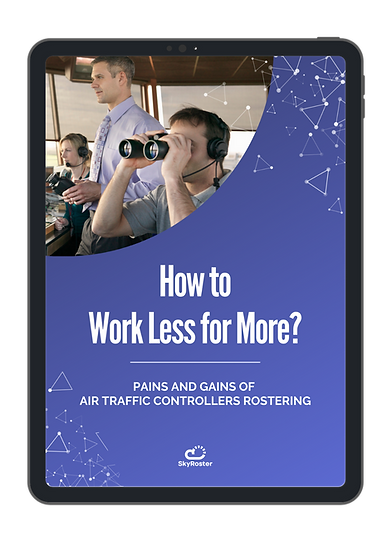
How to Work Less for More?
Pains and Gains of Air Traffic Controllers Rostering
.png)
A better day-to-day workforce scheduling process can be achieved by:
-
Gaining an understanding of ATCOs' difficulties;
-
Recognizing the benefits of rostering automation;
-
Offering a straightforward solution.
Get the free e-Copy about pains and gains of Air Traffic Controllers Rostering.
Working less for more is desirable for any job and industry.
But what does this mean for Air Traffic Controllers?
What you will find in this e-copy includes:
Essential Responsibilities of ATCOs in Rostering
Based on the insights collected during our research, the main aggregated jobs involved in Air Traffic Controllers Rostering are the following:
1. Creating ATCO rosters compliant with all fatigue rules, legal frameworks, labor regulation, internal and external requirements and staff working preferences. No two ANSP share the same rules and constraints. The set of constraints has to be dynamic (parameterizable) and easy to extend (adding new rules or constraints in case of regulation changes, etc.).
2. Simulating schedules with different shift patterns (fixed vs dynamic pattern, forward rotation vs. backward rotation), assigning different priorities to business goals (minimize costs, maximize efficiency/staff satisfaction), team vs. individual rosters, in order to find the optimum planning strategy. Many ANSPs have a separate rostering office (or a dedicated unit inside the HR department), which is responsible for optimizing the workforce scheduling KPIs and overallcompany objectives (optimizework-life balance, workforce cost reduction).
3. Managing staff competency levels, keeping track of licenses, ratings and endorsement validities, training and renewal needs. ATCOs need to be rotated on different working positions in order to reach the minimum number of hours required to maintain their licenses.
4. On-the-Job trainees Scheduling with their instructors. ANSPs have different rules on how they do these assignments. Some assign trainees with the same instructor, others rotate them between different instructors, and some of them are managing this allocation outside the normal ATCO rostering workflow.
5. Managing employees' personal data and files. ANSPs manage this specific HR task in different ways — separate HR software to store all staff data, integrated rostering & HR tools or plain old paper files.
6. Managing staff unavailability without disrupting the planning. Annual leaves, sick leaves, missions, training, medical checks, swap requests between employees, all have the potential to disrupt a viable roster. Each new staff request increases this probability. Again, ANSPs handle these processes in different ways: separated absence management software, Excel sheets or other tools integrated with the Rostering software, up to a certain degree.
Challenges in ATCO Rostering: Common Pain Points
1. Under- or over-allocation of Air Traffic Controllers on a specific working interval/shift.
Under-allocation leads to fatigue. Over-allocation leads to staff leakage and boredom. Besides the lack of efficiency, both fatigue and boredom pose serious safety risks — especially for ATC.
2. It is difficult and expensive to manually do the workforce planning each year and readapt schedules to last-minute changes.
Each Line Manager / Planner burns from a few tens of hours to a few hundred hours each year to do and redo the ATCO planning for all their managed teams.
3. Complying with ever-changing rules and constraints while making the roster for different periods.
This becomes increasingly difficult if done manually (Excel-based rostering).
4. Integrating staff working preferences and amenities (fewer night shifts after a certain age, more days of annual leave, etc.) into the rostering process.
Same as above, not a trivial task if a manual planning method is used.
5. Scheduling the qualified ATCOs to the right working position to maintain qualifications.
Smaller ANSPs developed a natural reflex for this, it’s easier to keep track of who is qualified for what sector. In other ANSPs, all controllers are licensed for all sectors. In larger ANSPs, this task becomes very challenging and time-consuming.
6. Adapting to disruptions in real-time.
Calling ATCOs to work from stand-by shifts in case of traffic spikes or unplanned leaves while making sure no planning constraint is broken. This is a huge pain for the majority of ANSPs. And most of them have no automation to deal with it.
Benefits of Automated Rostering for ATCOs
1. Full compliance with the regulation.
There is no room for misalignments, especially in a highly regulated industry like Air Traffic Control. The rostering platform must embed mechanisms that enforce this compliance.
2. Control and minimize fatigue risks.
As a great risk factor, fatigue needs special control and assessment measures for every Air TrafficController. The ATCO rostering tool must simplify the systemic control of fatigue and prevention of the associated fatigue risks.
3. Optimize workforce efficiency.
This platform must generate optimized ATCO schedules that maximize efficiency while reducing workforce costs.
4. Minimize time spent with workforce planning by Planning Managers / Rostering Office/ HR.
Any manual planning burns hundreds of hours of work each year. If the manual planning processes are automatized and blended with minimum human supervision, these hours can be invested in other more productive tasks.
5. Increase workforce flexibility and planning resilience.
Any change (regulation, sick leaves, pandemics, traffic variations, etc.) is a potential disruptive factor. A fully automated, digital platform for rostering Air Traffic Controllers will substantially increase flexibility and resilience to change, by adapting schedules in almost real-time.
6. Increase staff overall satisfaction and wellbeing.
At the end of the day, the workforce is the most valuable resource. The Rostering Platform must be able to take staff working preferences into account when generating the work schedule and balance workload between employees. It must distribute night shifts and public holidays evenly, must prevent and control the generated fatigue. The working schedules must help minimize premature aging, through less fatigue.
